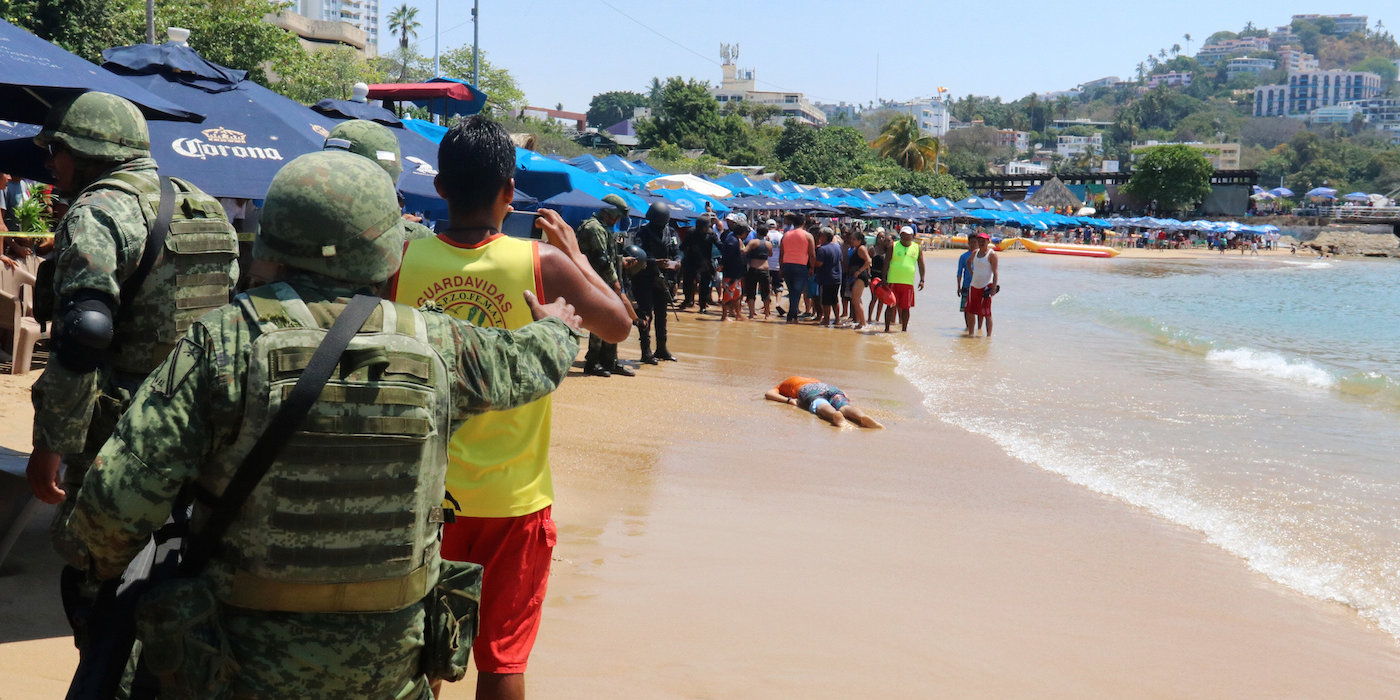- Deadly violence has increased in Mexico over the past several years.
- Tourist areas in particular have seen worrying spikes in killings and other crimes.
- But that violence affects Mexicans and tourists in those areas differently.
The upward trend of deadly violence in Mexico has continued after a record-setting 2017, when there were more than 29,000 homicide victims in the country.
This January and February combined saw 4,937 homicides, the most on record for the first two months of the year.
Some of the most intense violence hit the states where Mexico’s most popular tourist destinations are located, leading to concerns about the health of a major Mexican industry.
But the violence swirling around those tourist hubs affects visitors and residents in different ways, and even with the increasing insecurity, foreign travelers don’t seem to have been deterred.

In Quintana Roo, a Gulf coast state with resort areas like Playa del Carmen and Cancun, the 359 homicide victims in 2017 were a 117% increase over the 165 in the state in 2016. In the municipality of Solidaridad, where Playa del Carmen is located, the number of homicides rose from 37 in 2016 to 49 last year.
In Guerrero, which is home to Acapulco, the number of homicide victims have risen steadily, from 2,016 in 2015 to 2,318 in 2017. Acapulco has been a focal point, with the highest homicide rate among Mexican cities five times between 2011 and 2016. In 2016 the city had 918 homicides, rising to 1,096 last year.
Baja California Sur, the Pacific coast state where Los Cabos is located, has seen the most precipitous increase, from 151 homicide victims in 2015 to 610 in 2017. Los Cabos itself had 68 homicides in 2016 and 363 in 2017 - a spike that earned it the title of most violent city in the world last year.
'Those tourist areas ... tend to be pretty safe'

Violence in many of those municipalities takes place on the peripheries - away from the areas frequented by tourists.
In Quintana Roo, the principal causes of recent violence have been disputes between criminal groups over territory, extortion rackets, and drug sales, according to a federal report seen by El Universal in early 2017.
In many cases, tourists are the ones buying those drugs, but the local insecurity - facilitated by corruption, impunity, and social conditions - has the most severe affect on residents.
"We've been robbed with pistols and with other larger guns, but they never catch them," Laura, an employee at a pharmacy outside of Cancun's hotel zone, told CGTN America. "Everyone here gets robbed, because there's no security presence in Cancun."
In Acapulco, violence is also largely confined to marginalized areas on the outskirts of the city.
In January, 11 people were killed in a gunfight between residents and self-appointed community police in a neighborhood just south of the city. In mid-March, schools in communities west of the city shut down after armed men burst into several schools, robbing students and teachers and forcibly cutting their hair.
Los Cabos, at the tip of the Baja Peninsula, is adjacent to drug-trafficking routes between northwest Mexico and the southwest US, and competition over control of that territory, particularly among factions of the Sinaloa cartel, is believed to be the cause of much of the bloodshed there.
Some incidents in these places have taken place in areas tourists frequent - a nightclub shooting in Playa del Carmen in January 2017; a shooting that killed three people on a beach in Los Cabos in August 2017; and a man gunned down in broad daylight in front of beachgoers in Acapulco this week - but most tourists are not exposed to the violence.

"In Baja California in particular, La Paz has become fairly dangerous," said James Bosworth, founder of political-risk-analysis firm Hxagon, referring to the Baja California state capital, on the opposite side of the state from Los Cabos. "In the Cancun area, there's areas of Cancun, the city, [where there are] neighborhoods that tourists probably shouldn't go into, but most tourists aren't going there."
"For the average tourist going to Mexico, who's going to go hang out in Cancun on the beach and stay at a nice hotel around there, or for that matter down in Baja California, Mexico's a great place to go, and the security situation is not going to impact the average tourist in any significant way," Bosworth told Business Insider.
Travelers need to be aware of their surroundings, he said, "but those tourist areas, for most people who stay on the beaten path, tend to be pretty safe. The problems come when people go way off the path and hang out at some shady bar at 2 at night."
A US State Department travel warning in August named Quintana Roo and Baja California Sur for the first time, and their listing seemed to put a chill on tourism in the following months. The US lifted travel restrictions on those states in January (the same month US citizens were advised "do not travel" to Guerrero and four other states).
But for many US travelers - and the US airlines carrying them - Mexico remains an appealing destination.

"I'm more concerned about going to Chicago than Cabo because I hear there's someone killed every day there," Joel Boschee, of South Dakota, told The Dallas Morning News in March. "We've never run into any problems. It's always been friendly and fun. A nice place to visit."
"I just think of it as going out to downtown or something. It's the same kind of thing," Alisha Battle of Texas, who has traveled to Cancun in the past and is planning another trip there, told an NBC affiliate this month. "Bad stuff can happen there, so I mean, just be aware of your surroundings, but I think you have a good time."
"I go home every year, though, despite" the insecurity, Paola Hernandez-O'Connor, a New York City resident born in Mexico, told MarketWatch in March, after traveling to a wedding in Cancun. "I will never not go there."
'Most often those tourists are fine'
In 2017, 85% of the 35 million international visitors in Mexico were from the US. And amid record-setting violence last year, Los Cabos also set new tourism record in 2017, with 2 million visitors, up about 20% from 2016.
Authorities and business leaders in tourist areas are also working to provide more visible security.
Rodrigo Esponda, managing director of the Los Cabos Tourism Board, told The Morning News his group was "doubling our efforts to make sure tourists not only enjoy their visit, but feel safe at all times."

He said the government and civic leaders were increasing the military presence and that he and other business leaders agreed on a $47 million public-private partnership to improve security through measures like additional security cameras and providing new uniforms for service workers to help tourist identify them.
Cancun received extra soldiers and security personnel after a ferry bombing in February, which injured more than 20 people.
"It's the complete opposite situation of the insecurity many people think of," Roberto Cintron, president of the Cancun hotel owners' association, told USA Today. Cintron said hotel occupancy was around 83% - about the same it was last year.
Israel Uribe, a concierge in Playa del Carmen, said his bosses have told him, "Don't say anything" when asked about security in the area.
Those efforts are not likely to reassure locals, many of whom work for low pay and in poor conditions in the tourism sector and live in communities with few services and little government presence. A December survey found 84.9% of residents in Cancun considered the city "unsafe." A government survey found that 60% of people in Baja California Sur felt high levels of insecurity.
"Most tourists are going to the airport, going to their hotels, hanging out on the beach, maybe taking a quick trip into one of the towns ... and most often those tourists are fine," Bosworth said. "I think the perception of the security situation, it's affecting the Mexican citizens who live in the tourist towns far more than it's affecting the tourists."

